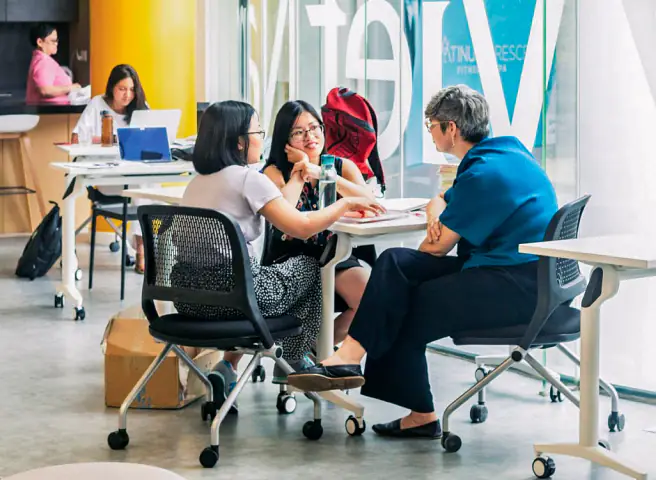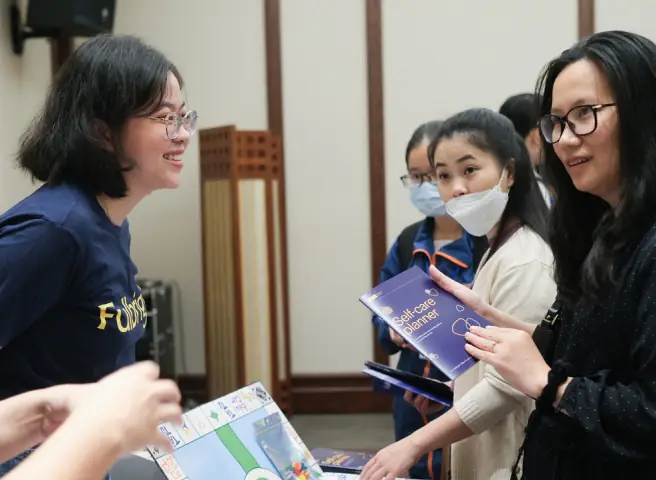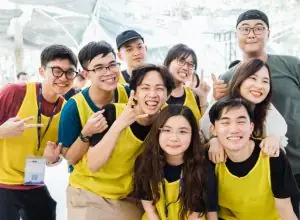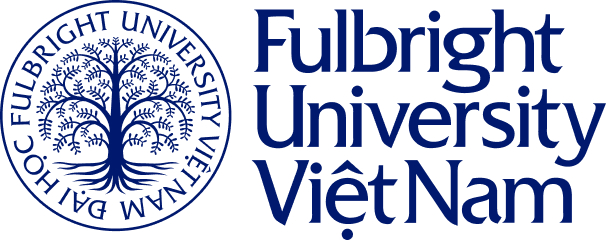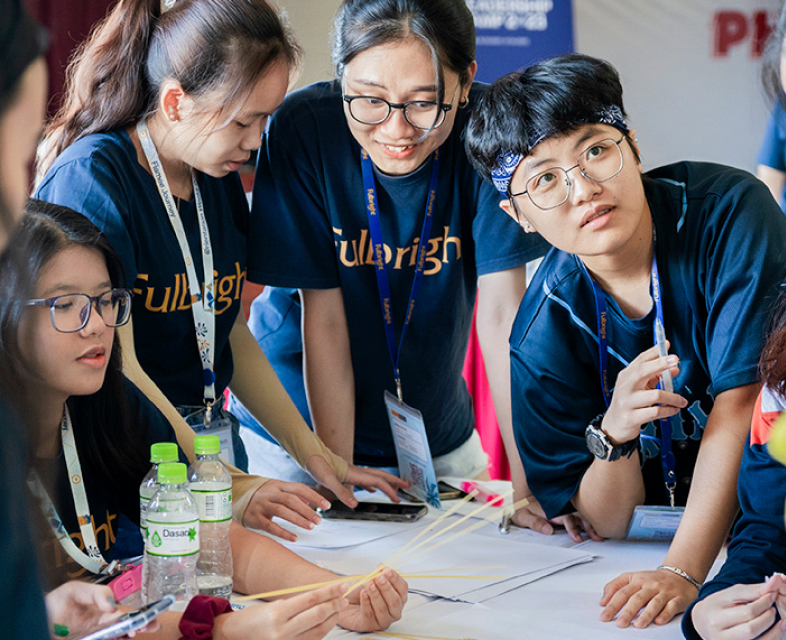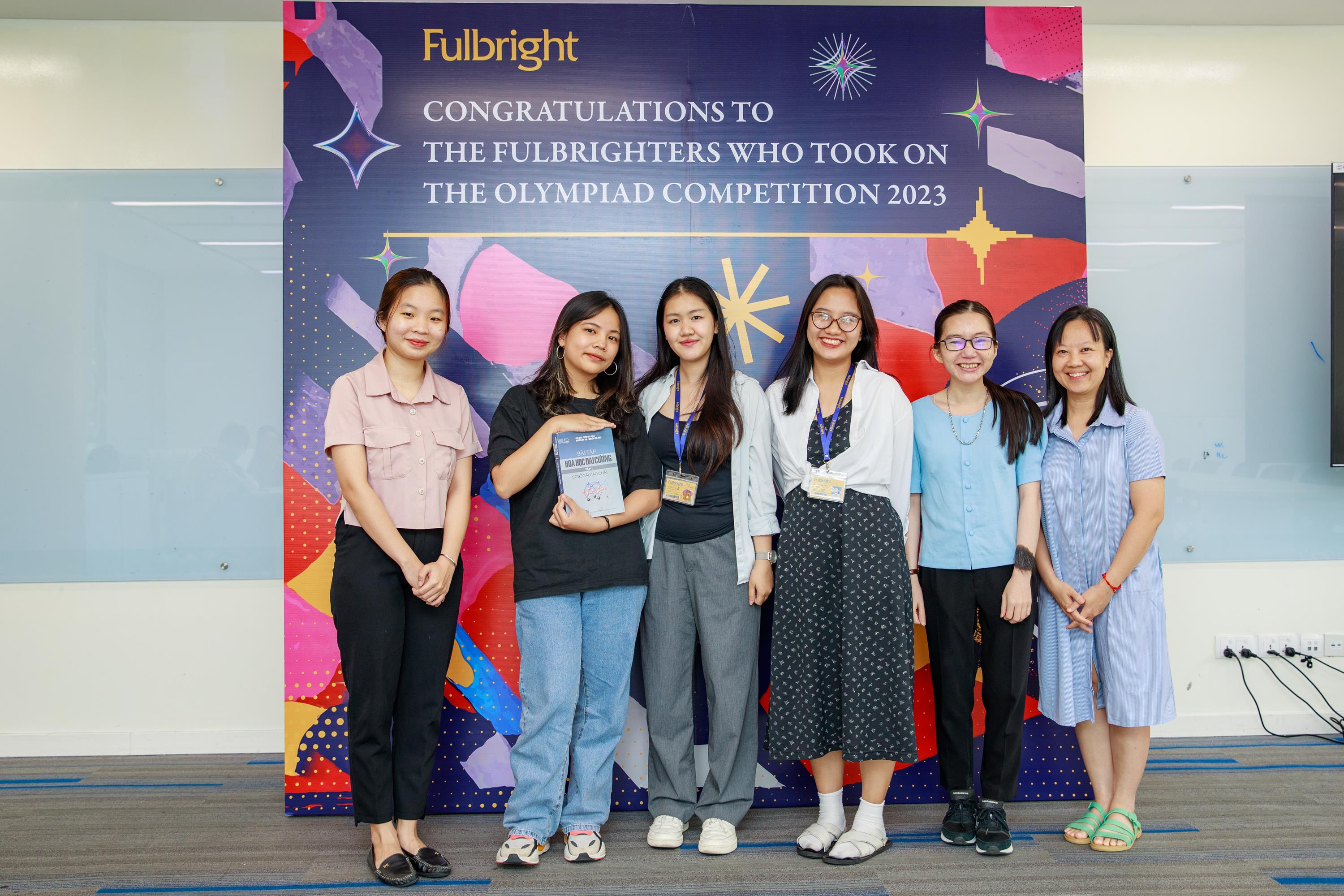
As the forced global experiment with online learning continues, Fulbright faculty strives to maximize the potential of online learning, pushing the boundaries of digital classroom engagement. An effort that raises particular challenges for heavily “hands-on” subjects with strong experimental components, such as Biology. And yet, the course ‘Biology of Infectious Diseases’, by Dr. Samhitha Raj, Fulbright professor and molecular biologist, is a perfect example of realized opportunities.
A thematically powerful and contextually relevant choice as COVID-19 continues to upend contemporary life, the course outlines the principles of germ theory, the mechanisms underlying viral infection and human immunity, methods to control infections and the whys and hows of epidemics and their containment, with a final focus on the defining pandemic of our time. The course therefore aims for students to develop a functional understanding of foundational biology all the while acquiring immediately relevant information. As Samhitha explains, “some of the questions we aim for our students to answer is: Despite being exposed to pathogens, why do only some of us get sick? Why do hand sanitizers tend to work on some viruses and not others? What is the difference between an infection and a disease? How do our bodies respond to pathogens? How do we control infections? How do epidemics happen?”
Although Biology courses rely heavily on hands-on experimentation, such as familiarizing students with the use of microscopes and laboratory procedures, opportunities to work directly in groups with specialized equipment remain heavily curtailed, if not impossible. Somewhat paradoxically, online learning creates an opportunity for first year students to study highly dangerous viral pathogens rather than amoebas – from the safety of their own homes. ‘Biology of Infectious Diseases’ was designed for online-only learning from the beginning, taking full advantage of a plethora of digital tools, as well as what is becoming Fulbright’s distinct brand of classroom engagement in virtual spaces, from self-study with interactive tools to group activities and student-led discussions. “I’m always looking to eliminate passive lectures. I much prefer to build discussion-heavy lessons, which are harder to implement online,” says Samhitha.

Dr. Samitha Raj
Samhitha’s solutions come primarily in 3 forms. Written materials, such as contemporary news pieces, scientific articles or archival documents were shared through a dedicated Facebook group. At-home experiments were designed with limited supplies in mind. Finally, specialized computerized tools allowed students to explore and compare publicly available genetic information of viral strains, mutations and vaccines, or understand the structures of specific functional proteins through a state-of-the-art protein modelling software. Each activity was designed to allow for student-led inquiry and discovery, and to emulate the scientific method; Samhitha’s goal is to foster an investigative, peer-based learning environment for future specialists and curious minds alike.
Scientific discovery for all learners
As Fulbright students come from a highly diverse background, retain the freedom to explore a variety of disciplines before specializing, and have had many different educational experiences in Vietnam or abroad, it was important for Samhitha to start from a review and primer on high-school level biology. The class does not necessitate a specialization: instead, Samhitha ascertains all participants begin on equal footing. “We start with the very basics of what microbes are, and then we can build upon that towards more complex forms of analysis. I cannot assume that everybody understands the concepts we use in class without redefining them,” explains Samhitha.
Once all students have been refreshed on key concepts, class activities begin in earnest. But even the more theoretical foundations, such as germ theory, are not delivered in lecture format. Instead, students retrace historically significant scientific discoveries. Namely, the beginnings of epidemiology in 1850 London, at the peak of a devastating cholera outbreak. Students were given maps, pictures, sample case records to analyze symptoms, and other archival material, before moving to the online conferencing platform Zoom. There, students hypothesized together on possible causes for the disease, and finally identified the now-famous water pump from which the germ originated.
For Quynh, currently enrolled in the class, it is exciting to “learn like we are following the footsteps of our scientific predecessors, figuring out the natural world. We were like detectives, collecting data around an epidemic, making hypotheses and testing them. With this approach, we understand the process of being a biologist and can apply the same rationale to how they save people from pandemics.”
“This is the scientific method: you take observations, and test hypotheses to deduce answers, like taking clues from everywhere to solve a puzzle. It’s a solid intellectual habit to form, and a great way for students to take charge of their own learning,” comments Samhitha.
The invisible made interactive
Students were also prompted to experiment at home by setting up bread cultures to mold, comparing microbial populations between a variety of surfaces and keep track of their scientific set-up. Students established a control group (clean hands) and each bread sample could only be used to swipe one surface. This activity was volunteer-based, as some students were limited in their mobility or access to grocery stores. But an important aspect was that results could be shared and discussed on the course’s Facebook group. As Samhitha reflects, “this was a chance for students to speak their mind and engage with each other’s experiments, teasing out the reasons for sometimes surprising results or to question methodology.” This also functioned as one of many workarounds to retain a tangible, relatable flavor to the subject of their lessons.
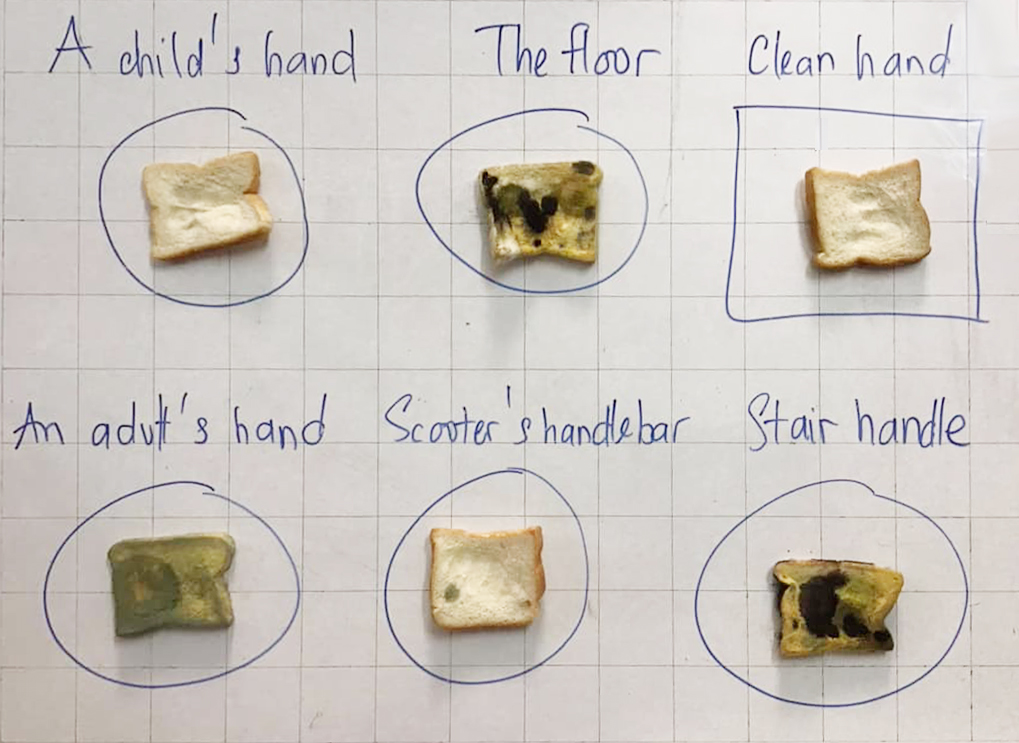
A student’s bread experiment
Indeed, a challenge of online learning for biology is a conspicuous absence of microscopes: this constitutes a hurdle for students to visualize what they theorize. Samhitha devised creative workarounds, making the invisible visible again so they would recover this sense of exploration.
Online visualization tools and databases were instrumental in moving beyond the abstract concepts. Before discussing protein structures, students ran a software to manipulate those structures in 3 dimensions, familiarizing themselves with the unseen forms that provide the key functions of proteins. The software allowed for detailed exploration, manipulation, and comparisons of structures. Students could also color specific parts for analysis and classroom discussion, teasing out the way they would act upon others. As the lesson moved to DNA sequences and mutations, students had the opportunity to compare parts of actual virus DNA sequences of similar strains, tracking how they mutate and change over time. Those professional tools are accompanied with information from a variety of sources and in many formats, from news to research papers, to videos and more ludic sources, all to prompt students to react or think differently about the topic discussed in class, forming a fertile soil for educational experimentation.
“It’s incredible how much information is available to the public, and how powerful the judicious use of digital tools can be. It’s important to keep students engaged, forming hypotheses and testing them with real world data they can ‘touch’, that they can manipulate and explore on their own and with each other, creating a solid knowledge base with continuously active and varied learning,” reflects Samhitha.
Learning through real problems
As mentioned above, the class emphasizes practice and real-world examples over abstract knowledge. Students dive deep into the research and discovery process inherent to good science. For example, the genetic sequences studied in class were taken from Ebola patients, and served to understand both how mutations work and the role they play in viral evolution and diseases spreading. For Samhitha, real world case studies are an incredible opportunity. “Although real data is messier, having the chance to study real world, historical examples is so much more meaningful. Students get to make true connections with the world around them, which really helps a concept stick.” Samhitha emphasizes.

Student’s comparison of E.coli and cholera bacteria, made with a protein modelling software
By providing real world examples from actual viruses such as Ebola, to historical pandemics from the Spanish influenza to COVID-19, students can study and engage with the material without knowing all the answers. Samhitha’s hidden goal is also to get students comfortable with uncertainty and the measure of chaos inherent to solving problems in the real world. “Real data has loose ends and false leads, incomplete information, misunderstandings, and downright misinformation to the public. But information gets better with each scientific contribution, with well-tested hypotheses and solid data, and solutions come to match. A 100 years ago, Spanish Influenza ravaged the world. Yet 4 months into this pandemic, the genome of COVID-19 is already available online, and prototype vaccines are being tested.”
This is why in Samhitha’s class, students are encouraged to try, to make mistakes, and to learn from them. For Quynh, “there is nothing wrong with being wrong in Samhitha’s class, only better experiments and more convincing studies. Any hypothesis can be entertained. Samhitha encourages each student to reflect, emphasizes considered opinions, and provides quality learning material. We get to feel less pressure and focus on our own growth.”
Students are supported from the very beginning to express their ideas, working through and explaining concepts at all levels from the microscopic to the macroscopic. Final assignments thus emphasize clarity of communication and breadth of scale, as class participants present case studies from a variety of perspectives, whether biological, genomic, epidemiological, or even from the social sciences. “By the end of the class, they should be able to mash it all together into a cohesive whole without losing the complexity of it, balancing clarity with sophistication,” explains Samhitha.
The balancing act also continues for Fulbright, as educators grapple with an unchanged mandate but a radically different world, and as students struggle with uncomfortable truths and uncertain futures. Some might think that the subject of dangerous viral strains and the mechanics of epidemiology might be coming too soon for comfort, too early for our classrooms. But to Samhitha, the opposite is true: “Although at first glance, the topic of the course can be a source of anxiety, it is my hope that with both a better familiarity with uncertainty, but also a better understanding of what constitutes credible information, students will be well equipped to face the challenges of our world.” Herein lies the Fulbright philosophy. When trouble comes, consider the multitude of perspectives, reflect, experiment. Learn from each other. Grow from all experiences. But most of all, never stop facing the future.
Antoine Touch
